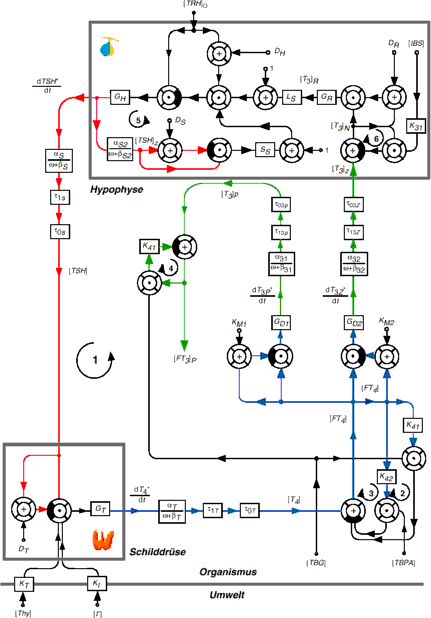
Thyrotropic Feedback Control
Mathematical models of the pituitary-thyroid axis:
In 1940, eleven years after the discovery of the thyrotropic hormone TSH by Aron in the year 1929, W. T. Salter postulated the existence of a control loop linking the pituitary and thyroid gland. This idea was inspired by the recent description of the two gonadotropic feedback control loops. Only a few years later, Astwood and Hoskins could reveal both the existence and the pathophysological relevance of this thyrotropic feedback control system. In 1968, Panda and Turner succeeded in a quantitative description ot the interdependence of thyroxine and TSH levels, but the first mathematical models of the feedback loop had already been developed up to 12 years earlier.
Over the years, these models were increasingly improved. As a consequence of this continued evolution, some of the newest models [Dietrich 2001, Dietrich et al. 2004 and Eisenberg et al. 2010] are also suitable for medical decision making.
Today, modelling of thyrotropic feedback control is faced with the challenge of newly discovered complexities in the information processing structure, e. g. Ultrashort feedback control of TSH secretion (Kakita-Laborde-Odell loop and Brokken-Wiersinga-Prummel loop) and long-feedback of iodothyronines on hypothalamic TRH release (Fekete-Lechan loop).
For a more comprehensive review of mathematical models of thyroid homeostasis see Dietrich et al. 2012.
A selection of historic and modern models:
Model
Year
Transfer characteristics
Information processing structure
1956
linear
phenomenological
1959
linear with basal secretion
phenomenological
1965
linear
phenomenological
1968
linear with basal secretion
phenomenological, partly parametrically isomorphic
1969
linear with basal secretion
phenomenological, partly parametrically isomorphic
1975
N/A
parametrically isomorphic
1976
logarithmic / linear
phenomenological, partly parametrically isomorphic
Seif 1977 logarithmic / linear phenomenological, partly parametrically isomorphic 1977
limit elements
phenomenological, partly parametrically isomorphic
1990
exponential
phenomenological
1995
complex polynoms
phenomenological, partly parametrically isomorphic
Dietrich et al.
1997
Michealis-Menten kinetics and linear elements
partly parametrically isomorphic (Model 2 - see below)
Dietrich et al.
1997
MiMe-NoCoDi model
parametrically isomorphic (Model 7.1 - see below )
Dietrich et al.
1998
MiMe-NoCoDi model
parametrically isomorphic (Model 9 - see below )
2001
MiMe-NoCoDi model
parametrically isomorphic (Model 10 - see below )
2005
based on compartment and flux analysis
parametrically isomorphic, but intrathyroidal kinetics only
Leow 2007 Second order Bernoulli differential equations with hysteresis,
inverse exponental power law of TSH responsepartly parametrically isomorphic 2010
Based on DiStefanos models from 1968, 1969 and 1975
parametrically isomorphic
Versions of nonlinear models based on or related to the MiMe-NoCoDI model:
Version
Comment
1
Michaelis-Menten kinetics in pituitary and thyroid gland (II-1997)
2
Introduction of time constants, plasma protein binding also for T3 (II-1997, presented at ETA '97)
3
Michaelis-Menten kinetics for 5'-Dejodinase
4
Type I and Type II 5'-Dejodinase differentiated
5
Feedback term changed (abandoned again, VIII-1997)
6
Feedback term corrected (VIII-1997)
7
Non competitive quotient inhibition in form of v-type allostery, plasma protein binding for T3 addressed in a more differentiated manner (VIII-1997)
7.1
Changed name conventions (XI-1997, presented in the colloqium of endocrine methods, university of Munich)
8
Ultra-short feedback in anterior pituitary introduced (IV-1998)
9
Ultra-short feedback now covering Michaelis-Menten kinetics (V-1998, presented at Symposium Gentianum 1999)
9.1
Changed name conventions, disturbances better addressed in simulation (IV-1999)
10
Intracellular binding substrate introduced (presented at EMCSR 2002, published with Logos-Verlag and in CBS)
11
Introduction of Long-feedback at TRH site (planned)
